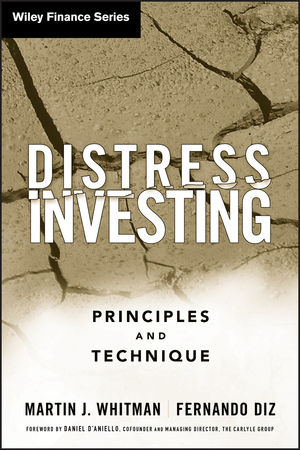Distress Investing: Principles and TechniqueISBN: 978-0-470-11767-5
Hardcover
272 pages
April 2009
 This is a Print-on-Demand title. It will be printed specifically to fill your order. Please allow an additional 10-15 days delivery time. The book is not returnable.
|
||||||
Foreword xiii
Preface xv
Acknowledgments xxii
Part One The General Landscape Of Distress Investing
Chapter 1 The Changed Environment 3
Trends in Corporate Debt Growth and Leverage before the Financial Meltdown of 2007–2008 4
Junk Bonds and the Levering-Up Period 6
The Syndicated Loan Market and Leveraged Loans 12
Financial Meltdown of 2007–2008 16
Principal Provisions of the 2005 Bankruptcy Act as They Affect Chapter 11 Reorganizations of Businesses 22
Chapter 2 The Theoretical Underpinning 27
What Market? 27
Toward a General Theory of Market Efficiency 29
External Forces Influencing Markets Explained 32
What Risk? 34
Capital Structure and Credit Risk 38
Valuation 39
The Company as a Stand-Alone Entity 41
Control and Its Vital Importance 42
Chapter 3 The Causes of Financial Distress 43
Lack of Access to Capital Markets 44
Deterioration of Operating Performance 46
Deterioration of GAAP Performance 48
Large Off-Balance-Sheet Contingent Liabilities 51
Chapter 4 Deal Expenses and Who Bears Them 53
Attorneys and Financial Advisers’ Compensation Structure and the Distribution of the Fee Pie 54
Time in Chapter 11 and Number of Legal Firms Retained 66
Determinants of Legal Fees and Expenses 67
Determinants of Financial Advisers’ Fees and Expenses 68
Can Professional Costs Be Excessive? 68
Appendix 69
Chapter 5 Other Important Issues 71
Management Compensation and Entrenchment 71
Tax and Political Disadvantages 73
Chapter 6 The Five Basic Truths of Distress Investing 77
Truth 1: No One Can Take Away a Corporate Creditor’s Right to a Money Payment Outside of Chapter 11 or Chapter 7 78
Truth 2: Chapter 11 Rules Influence All Reorganizations 82
Truth 3: Substantive Characteristics of Securities 84
Truth 4: Restructurings Are Costly for Creditors 86
Truth 5: Creditors Have Only Contractual Rights 87
Part Two Restructuring Troubled Issuers
Chapter 7 Voluntary Exchanges 91
Problems with Voluntary Exchanges 92
The Holdout Problem Illustrated 93
Making a Voluntary Exchange Work 94
Tax Disadvantages of a Voluntary Exchange versus Chapter 11 Reorganization 95
Chapter 8 A Brief Review of Chapter 11 99
Liquidations and Reorganizations 100
Starting a Case: Voluntary versus Involuntary Petitions 100
Forum Shopping 101
Parties in a Chapter 11 Case 101
Administration of a Chapter 11 Case 103
The Chapter 11 Plan 109
Chapter 9 The Workout Process 117
Parties and Their Differing Needs and Desires 117
Types of Chapter 11 Cases 120
Leverage Factors in Chapter 11 125
Part Three The Investment Process
Chapter 10 How to Analyze: Valuation 133
Strict Going Concern Valuation 134
Resource Conversion Valuation 146
Liquidation Valuations 148
Chapter 11 Due Diligence for Distressed Issues 151
Chapter 12 Distress Investing Risks 157
Risks Associated with the Alteration of Priorities 158
Risks Associated with Collateral or Enterprise Valuation 165
Reorganization Risks 168
Other Risks 168
Chapter 13 Form of Consideration Versus Amount Of Consideration 171
Part Four Cases and Implications for Public Policy
Chapter 14 Brief Case Studies of Distressed Securities, 2008–2009 177
Performing Loans Likely to Remain Performing Loans 178
Small Cases 182
Large Cases 184
Capital Infusions into Troubled Companies 184
Chapter 15 A Small Case : Home Products International 187
The Early Years 188
Growth by Acquisitions 189
Retail Industry Woes 192
The Fight for Control 195
Amendment of Indenture and Event of Default 196
The Decision: Prepackaged Chapter 11 197
Treatment of Impaired Classes under the Plan 198
Financial Means for Implementation of the Plan 199
Going-Concern and Liquidation Valuations 199
Chapter 16 A Large Reorganization Case: Kmart Corporation 203
Landlords and Unexpired Leases 204
Vendors and Critical Vendor Motions 206
Management and KERPs Pre-2005 BAPCPA 208
Fraudulent Transfers 209
Subsidiary Guarantees and Substantive Consolidation 210
Chapter 11 Committees and Out-of-Control Professional Costs 211
Blocking Positions 211
Buying Claims in Chapter 11 214
Debtor-in-Possession Financing 215
Kmart’s Plan of Reorganization and Plan Investors 218
Investment Performance 222
Chapter 17 An Ideal Restructuring System 225
Feasibility and Cash Bailouts 226
Good Enough Rather Than Ideal 226
Highly Beneficial Elements in the U.S. Restructuring System 226
Goals of an Ideal Restructuring System 228
Suggested Reforms 229
Notes 233
About the Authors 238
Index 239



